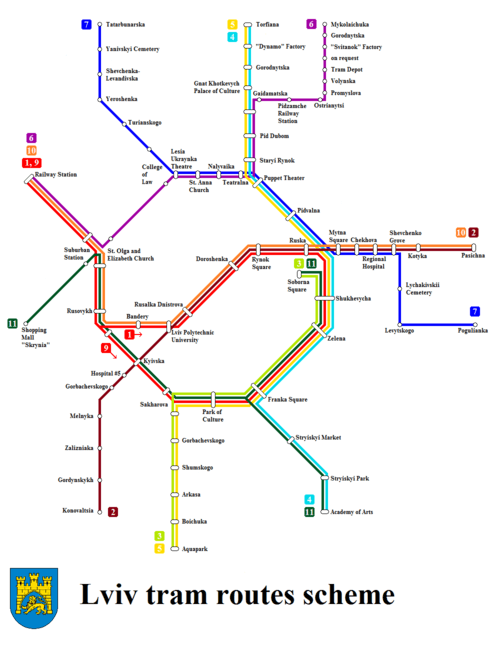Trams in Lviv
|
| |
| Overview | |
|---|---|
| Locale | Lviv, Ukraine |
| Transit type | Tram |
| Number of lines | 9 |
| Operation | |
| Began operation | 1880 |
| Technical | |
| Track gauge | 1,000 mm |
The Lviv tram (Ukrainian: Львівський Трамвай, translit.: L’vivs’kyi Tramvai) is an electric tramway in Lviv, Ukraine.
History
In the second half of the 19th century, urban development of cities within the Austro-Hungarian Empire created communication problems, which occasionally led to the construction of transit systems. The first projects for the construction of horse-drawn trams appeared in the 1870s. This network was called Konka after the Polish word for horse, koń. A horse-drawn tramway was built in Lviv and opened on May 5, 1880. The gauge of this first line was 1 meter. In 1906, the Lviv city administration took control of the tramway. In 1908, the tramway was fully electrified.
Running parallel to the Lviv tramway, was the Siemens & Halske tramway which opened on May 31, 1894. In 1896, the Lviv city administration took control of the Siemens & Halske tramway. Only on October 1, 1922, after the city became part of the Second Polish Republic were the tram lines switched to the right-hand-side system.
After the end of the Second World War and the annexation of the city by the Soviet Union, several lines were closed for service, yet most of the tramway infrastructure was preserved. On November 27, 1952, some tram lines were changed to the trolleybus systems. Starting in the 1970s, some lines in the city centre were shut down. In 1988, the first fast tram (now operated by the lines 3 and 5) was established in the city. Since then no extensions to the tram network have been built, however various extensions have been planned, most notable of which is the planned tram line to Sykhiv district.
Another characteristic of the Lviv tram is the grooved rail that is used. It is one of a few cities of the former Soviet Union that use this type of rail. This oddity resulted from the fact that, when the system was constructed, Lviv was part of Galicia in Austria-Hungary.
.jpeg)
Modern trams
Today, the Lviv tramway runs 10 lines on 75 kilometers of tracks with approximately 220 cars. Previously in bad shape, many tracks were reconstructed in 2006, and even more are to be reconstructed in the subsequent years. Most of the trams are the KT4 type, produced by Czech ČKD Tatra Works. Older T4+T4 trams operate only on the second line. Pre-war Gothaer Waggonfabrik cars, which were built after 1910, are only used for maintenance and utility purposes. Recently Lviv acquired 20 overhauled and modernised KT4 trams previously used in German cities Erfurt and Gera, with them being the first new tramcar purchase since the independence of Ukraine.
In 1991, nearly 140 million passengers used the system. By 2002, this had decreased to 60 million. Despite a large number of passengers, approximately 65% of them ride free of charge. Thus, the considerable debt of the company must be covered by the government of the Lviv Oblast.
The price of a single trip was 50 kopecks (about €0.08) in 2007. It was raised to 75 kopecks (about €0.12) in 2008 and to 1 hrn in 2009. The price as of 2012 is 1 hrn and 50 kopecks, with the cost having risen from 1 hrn and 25 kopecks just prior to the Euro 2012 football championships as Lviv was one of the host cities. In April 2015 the price of a single trip was 2 hrn (about €0.08).
In September 2012, a contract to supply modern low-floor trams was awarded to Elektrotrans, a joint venture of Electron and TransTec Vetschau.[1] These newest additions to Lviv's long tram history were introduced in August 2013 and now run on route 9a. There are five sections in the 100% low floor tram Electron T5L64, designed by Lviv's constructors in the Lviv-based company Electron.
Images
- Trams in Lviv
 Tram type T4SU at line 2
Tram type T4SU at line 2
 Tram KT4SU, line 9
Tram KT4SU, line 9 Lviv's tram depot
Lviv's tram depot- Modern low-floor tram Electron T5L64 on route 9a
Routes

See also
| Wikimedia Commons has media related to Trams in Lviv. |
References
- ↑ "World rolling stock market September 2012 - Railway Gazette". Railway Gazette International. Retrieved 24 September 2012.
External links
- lviv.tramvaj.ru - Lviv tram history (Ukrainian)/(Polish)/(Russian)
- Tramway in Lviv (English)/(German)
